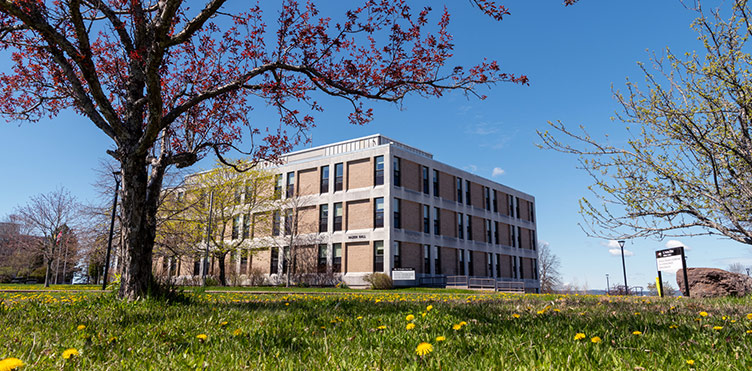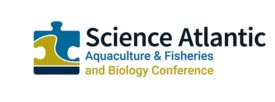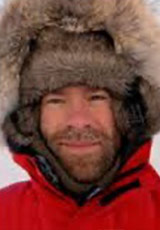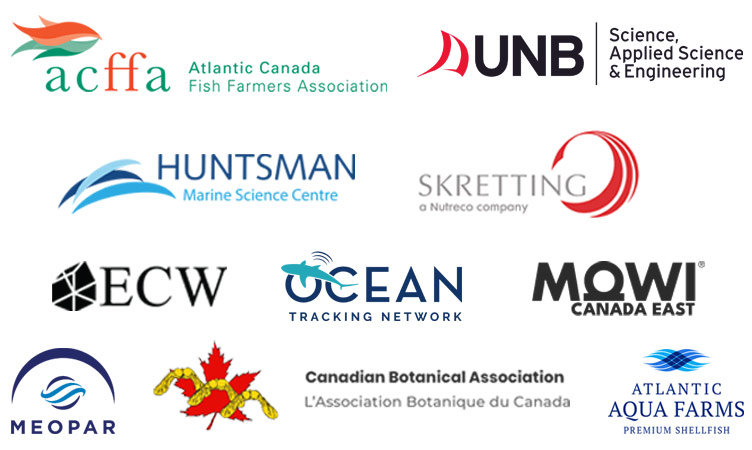Science Atlantic Aquaculture & Fisheries (A&F) and Biology Conference

The Science Atlantic Aquaculture & Fisheries (A&F) and Biology Conference will be hosted by the University of New Brunswick Saint John on March 3, 4 and 5, 2023.

The joint Science Atlantic A&F and Biology Conference is an annual event that brings together students from across Atlantic Canada to share their research, and network with other students and faculty. We are very excited to welcome everyone to our beautiful city.
Several awards will be given out at the conference, including the Biology awards and the Aquaculture and Fisheries awards.
Conference at a glance
General notes
There is a student photographer (Kate Gingles) at the conference who is authorized to take photos throughout on behalf of Science Atlantic. A selection of these photos will be made available by Science Atlantic after the conference.
There is at least one attendee with a severe peanut allergy. Please do not eat peanut products in the auditorium or during the poster session.
The conference face masking policy is as follows:
- Face masks are required when seated in the auditoriums.
- Face masks are optional in other shared indoor spaces on campus, including breaks, the poster session and travelling through common areas.
- UNB remains a mask-friendly environment and we encourage those who wish to wear masks on campus to do so.
Friday, March 3
5:30 - 7:30 p.m. | Ice breaker and registration, Saint John Alehouse, 1 Market Square
7 - 8 p.m. | Aquaculture & Fisheries and Biology Committee Dinner (Faculty rep members only). Whitebone Pizzeria - UNB Saint John
8 - 9 p.m. | Biology Committee Meeting (Faculty rep members only). Aquaculture & Fisheries Committee Meeting (Faculty rep members only)
Saturday, March 4
8 - 8:30 a.m. | Registration and put up posters, hallway outside Ganong Hall Lecture Theatre
8:30 - 8:45 a.m. | Welcome address, Ganong Hall Lecture Theatre
8:45 - 9:45 a.m. | Keynote speaker, Biology. Dr. Nicolas Lecomte, University of Moncton. Ganong Hall Lecture Theatre
9:45 - 10:15 a.m. | Break and poster viewing. Hallway outside Ganong Hall Lecture Theatre
10:15 a.m. - noon | Presentations - Session 1. Ganong Hall Lecture Theatre - Biology, Irving Hall 107 - A&F
Noon - 1 p.m. | Lunch, Baird Dining Hall
1 - 2 p.m. | Keynote speaker. Dr. Steve Backman, Skretting and Magellan Aqua Farms Inc. Ganong Hall Lecture Theatre
2 - 3:45 p.m. | Presentations - Session 2. Ganong Hall Lecture Theatre - Biology, Irving Hall 107 - A&F
3:45 - 4 p.m. | Break and poster viewing
4 - 5 p.m. | Poster viewing (posters will be judged at this time). Hallway, outside Ganong Hall Lecture Theatre
6:30 - 8:30 p.m. | Banquet, Baird Dining Hall
Sunday, March 5
9 - 10:30 a.m. | Presentations - Session 3. Ganong Hall Lecture Theatre - Biology, Irving Hall 107 A&F
10:30 - 11 a.m. | Break and poster viewing
11 - noon | Presentations - Session 4. Ganong Hall Lecture Theatre - Biology, Irving Hall 107 A&F
Noon - 1 p.m. | Lunch, Baird Dining Hall
1 - 2 p.m. | Awards ceremony and closing. Ganong Hall Lecture Theatre
Aquaculture & Fisheries presentations
Presentations are 15 minutes in length with two to three minutes for questions and transition to the next student.
Session 1 | Saturday, March 4
Kelsey Mercer
10:15 - 10:30 a.m. | Changes in the biological characteristics of Atlantic salmon (Salmo salar) in the Miramichi River, New Brunswick, with respect to changing river variables.
Kate Gingles
10:30 - 10:45 a.m. | The role of Atlantic salmon (Salmo salar) in ecological restoration: Insights from five Atlantic Canadian national parks.
Hannah Lazaris-Decken
10:45 - 11 a.m. | Molecular identification of saprolegnia parasitica infesting hatchery-reared Atlantic salmon and in vitro assessment of prophylactic treatments.
Juan Manriquez-Hernandez
11 - 11:15 a.m. | Assessment of natural astaxanthin extracted from the microalga haematococcus pluvialis flotow, 1844 for use in Atlantic salmon (salmo salar linnaeus, 1758) feeds.
Sarah Babaei
11:15 - 11:30 a.m. | Determining stock structure of cod in a Newfoundland subdivision using next-generation sequencing.
Jacob Reicker
11:30 - 11:45 a.m. | Environmental DNA for surveillance of anadromous and freshwater fishes upstream of the Mactaquac generating station.
Emma-Jean Freeman
11:45 - noon | An exploration of methods to measure stress in aquaculture fish caused by parasitic freshwater mussel glochidia.
Session 2 | Saturday, March 4
Bailey Hatcher
2 - 2:15 p.m. | Cryopreservation of heart and liver mitochondria from brook trout (salvelinus fontinalis).
Micah Lea
2:15 - 2:30 p.m. | Mitochondrial function and ROS production in brook trout (salvelinus fontinalis) cardiomyocytes using fatty acids in hypoxic conditions.
Christopher Baker
2:30 - 2:45 p.m. | The effect of dietary supplementation of Astaxanthin on acute hypoxia and Temperature tolerance in triploid and tiploid brook charr, salvelinus fontinalis.
Angelisa Osmond
2:45 - 3 p.m. | Seaweed products as multi-functional feed additives for farmed juvenile rainbow trout.
Kate Storey
3 - 3:15 p.m. | Macroinvertebrate population of the Medway River and its ramifications on Atlantic Salmon.
Sam Nunn
3:15 - 3:30 p.m. | Exploring immune gene expression in striped bass (morone saxatilis) in response to mercury contamination.
Abigale Culberson
3:30 - 3:45 p.m. | The spatial ecology of invasive largemouth bass (micropterus salmoides) in the Wolastoq (Saint John) River.
Session 3 | Sunday, March 5
Gabriel Cassoni
9 - 9:15 a.m. | Validating a method to predict hatch of American lobster (homarus americanus) in southwest Bay of Fundy.
Mary Whipple
9:15 - 9:30 a.m. | Can hatch time of the American lobster (homarus americanus) be accurately predicted using embryos raised detached from a female’s brood?
Maddison Brown
9:30 - 9:45 a.m. | Effect of gear type on growth and shell shape of cultured eastern oysters (crassostrea virginica).
Sofia D'Angelo
9:45 - 10 a.m. | Investigating the thermal biology of the orange-footed sea cucumber (cucumaria frondosa).
Kenzie Melanson
10 - 10:15 a.m. | Effect of extended cold storage on motility and swimming kinematics of the sperm of shortnose sturgeon.
Delaney Hicks
10:15 - 10:30 a.m. | Addressing the inconsistencies between the catch and trade data for sharks and rays through updated estimates of conversion factors.
Session 4 | Sunday, March 5
Annie McMullon
11 - 11:15 a.m. | Why North Atlantic right whales are more susceptible to extinction compared to southern right whales.
Anagha Pradeep Kumar
11:15 - 11:30 a.m. | Kale (Brassica oleracea L.) seed germination and geedling growth responses to sea minerals.
Adeola Adelugba
11:30 - 11:45 a.m. | Changes in compost microbial profile with the prevalence of microplastics.
Koushika Kumaresan
11:45 - noon | Environmental impact of pentachlorophenol, the need for an alternative wood preservative.
Biology presentations
Session 1 | Saturday, March 4
Julia Ball
10:15 - 10:30 a.m. | Experimental evidence for bird, mammal and invertebrate frugivory across boreal forest habitats on the island of Newfoundland.
Ada Clarke
10:30 - 10:45 a.m. | Post-mating reproductive isolation across eastern and western populations of cardinal flower (Lobelia cardinalis).
Sophia Fraser
10:45 - 11 a.m. | A storm is brewing: Effects of hurricane Fiona on staging Semipalmated Plovers in the Northumberland Strait.
Genevieve Gauthier
11 - 11:15 a.m. | Spatial genetic and temporal structuring in a breeding colony of Red-breasted Mergansers (Mergus serrator) at Kouchibouguac National Park.
Sara Leslie
11:15 - 11:30 a.m. | The effect of forest harvest practices on salamander populations.
Riley McInnis
11:30 - 11:45 a.m. | Anticamouflage: Do plants change colour in the autumn to reveal their pests?
Kathleen McVittie
11:45 - noon | Fine-scale spatial distribution of northern bottlenose whale (hyperoodon ampullatus) calves on the Scotian shelf between 1988 and 2021.
Session 2 | Saturday, March 4
Jenna Scott
2 - 2:15 p.m. | The effects of Atlantic puffin (Fratercula arctica) and Leach's storm petrel (Oceanodroma leucorhoa) on plant species richness and composition.
Gabrielle Crouse
2:15 - 2:30 p.m. | Using CRISPR/Cas9 for gene deletion in yeast.
Fiona Ewart
2:30 - 2:45 p.m. | Testing for hybridization between killifish species on the eastern coast of New Brunswick.
Lauren McGrath
2:45 - 3 p.m. | Expression analysis of duplicated paralogues encoding a central regulator of extracellular matrix remodeling at mRNA and protein levels in the developing zebrafish embryo.
Shelby Squires
3 - 3:15 p.m. | Hijacking of a conserved inducible promoter by a newly-evolved primate long noncoding RNA.
Bridget Ward
3:15 - 3:30 p.m. | HSP70 and HSP90 mRNA expression in Danio rerio brain following exposure to ammonia and hypoxia.
Mia Lauzon
3:30 - 3:45 p.m. | Impacts of pathogen infection on the winter behaviour and physiology of the black-legged tick, Ixodes scapularis.
Session 3 | Sunday, March 5
Benjamin Caron
9 - 9:15 a.m. | The Temporal and Physiological Dynamics of the Heterophyllous Transition in Myriophyllum aquaticum.
Amirarsham Farahmand
9:15 - 9:30 a.m. | Pain and the social brain: Evaluating the effects of a noxious stimulus on expression of the prosocial hormone, parathyroid hormone 2.
Aynsley McDermott
9:30 - 9:45 a.m. | Understanding the relationship between Asp and calmodulin at spindle poles.
Max Spiess
9:45 - 10 a.m. | The acquisition of symbiotic green algae in the egg masses of the spotted salamander.
Mayara Majri
10 - 10:15 a.m. | Microbe-derived inhibition of white-nose syndrome in hibernating North American bats.
Taryn Muldoon
10:15 - 10:30 a.m. | A spatiotemporal analysis of the causative agent of white-nose syndrome and intestinal macroparasites based on DNA from Nova Scotia bat guano.
Session 4 | Sunday, March 5
Langston Tench
11 - 11:15 a.m. | Quantifying the morphology of tracheal cartilage and the flexibility of the neck of chicken embryos.
Chloe Cyr
11:15 - 11:30 a.m. | Natural killer cells and pancreatic ductal adenocarcinoma: Investigating the NKp30 / B7-H6 axis.
Sierra Hedges
11:30 - 11:45 a.m. | Using EEG alpha oscillations and microstate dynamics to chart maturation and functional brain networks.
Hwanhee Jeon
11:45 - noon | Imaging pathological stomach tissue using polarization-sensitive second harmonic generation microscopy.
Keynote speakers
Dr. Nicolas Lecomte
Tracking climate changes in polar ecosystems

Canada Research Chair in Polar and Boreal Ecology
Associate Professor, Université de Moncton
Abstract
We are living unprecedented climate shifts, and, in my presentation, I will focus on the Arctic as the area on Earth where those changes are the fastest and strongest. I will show different efforts made with collaborators and students to track the impacts of those changes on terrestrial arctic ecosystems.
From population studies of shorebirds to population genetics of key arctic species such as the snowy owls and the caribou, to food web modelling, we are trying in our lab to tackle some of the big challenges of tracking changes that can happen even faster than our traditional field methods allowed us to.
Biography
Dr. Lecomte is passionate about birds and their protection, ecosystems studies and educating the next generations of nature enthusiasts and biologists and running community-driven projects in the Arctic with Inuit. Dr. Lecomte’s research aimed at understanding the impact of climate changes and other global perturbations on ecosystems and animal populations, with a special focus on migratory birds and their predators in polar areas.
Dr. Lecomte was an Arctic resident for ten years and worked as a biologist for the Government of Nunavut, he spent three years in Antarctic islands as a biologist and research scientist and led Arctic and Antarctic expeditions for more than 20 years. Dr. Lecomte is senior editor for Methods in Ecology and Evolution and associate editor for Oecologia.
Dr. Steven Backman
The future of aquaculture in Canada: developing Recirculating Aquaculture Systems (RAS) and diversifying into invertebrates and seaweeds

Aquaculture Veterinarian and Product Manager North America, Skretting North America East President, Magellan Aqua Farms Inc.
Abstract
Nov. 15, 2022, marked a significant milestone in human history. It is the day the human population reached 8 billion. Globally, our food productions have been strained to keep pace with demand. Food waste and population growth continue to increase the pressure we are placing on global resources.
The challenge to us, as society, is to be able to increase our food supply in a sustainable way. Aquaculture presents some unique opportunities to contribute to a solution. A brief look at the evolving technologies in aquatic food production and the potential constraints are presented.
Biography
Dr. Steven Backman began his aquaculture career as a research and extension officer at the Ontario Veterinary College in a collaborative program with the Ontario Ministry of Agriculture and Food to assist tobacco farmers transition to more sustainable crops through the adoption of land-based aquaculture.
In 1988, he was presented the opportunity to return to Atlantic Canada to head up the Veterinary Services Office for Moore-Clark Canada, a division of BP Nutrition. In his current role, Dr. Backman is Product Manager North America for Skretting. In his off time, he enjoys working at his Integrated Multi-Trophic Aquaculture (IMTA) operation, Magellan Aqua Farms Inc., in Bocabec Bay and St. Stephen, New Brunswick. He volunteers in several community organizations, including serving as President of the Charlotte County Hospital Board of Trustees.
Dr. Backman holds a Diploma in Agriculture from the Nova Scotia Agricultural College, Doctor of Veterinary Medicine Degree and Diploma in Anatomical Pathology from the Ontario Veterinary College, University of Guelph, Ontario. He is a USDA-accredited veterinarian and is licensed in several jurisdictions; he serves as IACUC Veterinarian for the USDA ARC in Maine. He is the Charter President of the Canadian Association of Aquatic Veterinarians and Charter Secretary of the Eastern Association of Aquaculture Veterinarians.
Posters
Aquaculture & Fisheries
Esther Ataikiru
Effect of photoperiod and light intensity on picocyanobacterial growth rate.
Emily Blacklock
Combining archival tag data with ocean bathymetry and circulation models to infer migration paths of adult American lobster (Homarus americanus) in the Bay of Fundy/Gulf of Maine.
Emily Gibbons
Giant Irish moss, blue mussel clumps influence local-scale biodiversity in Basin Head, a marine protected area in Prince Edward Island.
Marijune Tiamzon
Impact of maternal size on brood size and hatch characteristics of American lobster, Homarus americanus.
Brandon Vriends
Mussel-giant Irish moss associations and their role on trophic interactions in Basin Head, Prince Edward Island.
Biology
Victoria Adams
Is HSP70 upregulated in freeze-tolerant crickets?
Samantha Beaton
Bacteria with nitrogen-fixing potential associated with ectomycorrhizae and surrounding Sphagnum moss.
Makatendeka Biton
Developing a localized surface plasmon aptasensor for the early detection of acute myocardial infarction.
Makayla Butorac
Body and tentacle movement patterns of lymnaea stagnalis in different environmental conditions.
Ashley Chiasson
Improved inference and analysis of the fungal DNA component within the microbial metagenome of pediatric oncology patients.
MinSang Cho
Uncovering bacterial interactions within dinoflagellates culture using genomics.
Nicole Daley
The histology of endochondral ossification in larval zebrafish tails.
Julie Ann Francois
Examination of diurnal activity patterns, social behavior, enclosure use and impact of visitor density in four species of penguins in captivity.
Hope Gorveatte
Investigating the relationship between CDK1 and Asp in mediating transit amplification of stem cell progeny in the drosophila germline.
Shreya Hande
The microarchitecture of harp seal bacula.
Sasha MacArthur
Offspring provisioning rates in an urban passerine: Do they change with parental age?
Peter MacGregor
The paradox of black ash: Environmentally variable yet rare.
Kelly MacInnis
Investigating the effect of hybridization on killifish metabolic rate.
Thomas MacLellan
The effects of liming on litter decomposition in freshwater streams and ponds.
Jack Nason
An assessment of inner Bay of Fundy Atlantic salmon (salmo salar) spawning success in Fundy National Park.
Daniel Plamondon
Developing a yeast based assay to study plant transport proteins.
Jacob Power
The acute and chronic effects of chemotherapy treatment on prefrontal cortex neurons.
Logan Reid
Comparing different types of phytoplankton community measurements to develop an optimal harmful algae monitoring strategy.
Lenayah Ryan
The impact of chain pickerel invasion on yellow lampmussel and their fish host in Cape Breton, Nova Scotia.
Gregory Santangeli
Environmental DNA detection of Atlantic salmon (salmo salar L.) via the use of novel nuclear repeat-based primers.
Lauren Schofield
Physiological responses in shrubs to coastal salt exposure.
Tayah Sommer
The function and regulation of kynurenine pathway intermediates in breast cancer metabolism.
Courtney Strugnell
Does methane regulate growth and physiological processes of heat-stressed canola plants?
Emily Templeman
Effects of a TAAR1 agonist on energy metabolism in breast cancer cell lines.
Jessica Thompson
Understanding whether cyclin-dependent Kinase 1 has a germline Stem Cell-specific mitotic role mediated through Asp.
Alyssa Wells
Mate fidelity in a double-brooded urban passerine.
Alexandra Wright
Gene expression in response to salt stress mediated by genome doubling in hordeum bulbosum.
Accommodations
Hotels rooms in the reserved blocks contain two queen sized beds so that students can share rooms to reduce travel costs.
Days Inn by Wyndham
Address: 175 City Road, Saint John, N.B.
Phone: 506-646-0366
Group rate: $105 + tax, 2 queen sized beds; breakfast included and available from 6 am to 10 am. Book by Feb. 10 to get the group rate. Space is limited so book early.
Booking available over the phone only. Tell them you are booking with the Science Atlantic Conference to receive the group rate.
Holiday Inn Express & Suites
Address: 400 Main Street, Saint John, N.B.
Phone: 506-642-2622
Group rate: $129 per night + tax; 2 queen sized beds. Book by Feb. 15 to get the group rate. Space is limited so book early.
Tell them you are booking for the Science Atlantic Conference if booking over the phone, or book online.
Participating schools
Each participating school has a Science Atlantic Biology Conference representative who can answer your questions:
- Kim Davies (UNB Saint John)
- Lori Borgal (MSVU)
- Lois Murray (DAL)
- Stevan Springer (UPEI)
- Russell Easy (Acadia)
- Nicanor Gonzalez-Morales (DAL)
- David Filice (Mount Allison)
- David Chaisson (SMU)
- Gilles Miron (UMonc)
- Shawn Craik (U Ste. Anne)
- Jantina Toxopeus (StFX)
- Craig Purchase (Memorial)
- Kellie White (CBU)
Conference organizers
- Dr. Kimberley Davies, Biology Conference Chair
- Dr. Thierry Chopin, Aquaculture & Fisheries Conference Chair
General inquiries: kim.davies@unb.ca
Thank you to our sponsors
- Atlantic Aqua Farms
- Atlantic Canada Fish Farmers Association
- Canadian Botanical Association
- Eastern Charlotte Waterways
- Huntsman Marine Science Centre
- Marine Environmental Observation, Prediction and Response Network
- MOWI Canada East
- Ocean Tracking Network
- Skretting North America East
- UNBSJ Department of Biological Sciences
- UNBSJ Faculty of Science, Applied Science and Engineering

